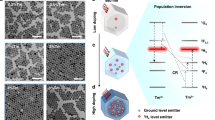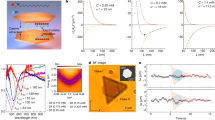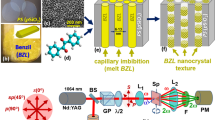Abstract
The combination of bottom-up and top-down processes to organize nanophases in hybrid materials is a key strategy to create functional materials. We found that oxide and sulphide nanocrystals become spontaneously dispersed in organic media during the self-assembly of nanoribbon supramolecular polymers. These nanoribbon polymers form by self-assembly of dendron rodcoil molecules, which contain three molecular blocks with dendritic, rod-like, and coil-like architectures. In an electric field these supramolecular assemblies carrying bound nanocrystals migrate to the positive electrode in an etched channel and align in the field. In the system containing ZnO nanocrystals as the inorganic component, both phases are oriented in the hybrid material forming an ultraviolet lasing medium with a lower threshold relative to pure ZnO nanocrystals.
This is a preview of subscription content, access via your institution
Access options
Subscribe to this journal
Receive 12 print issues and online access
$259.00 per year
only $21.58 per issue
Buy this article
- Purchase on Springer Link
- Instant access to full article PDF
Prices may be subject to local taxes which are calculated during checkout







Similar content being viewed by others
References
Bawendi, M.G., Steigerwald, M.L. & Brus, L.E. The quantum mechanics of larger semiconductor clusters (“quantum dots”). Annu. Rev. Phys. Chem. 41, 477–496 (1990).
Murray, C.B., Kagan, C.R. & Bawendi, M.G. Self-organization of CdSe nanocrystallites into three-dimensional quantum dot superlattices. Science 270, 1335–1338 (1995).
Alivisatos, A.P. Semiconductor clusters, nanocrystals, and quantum dots. Science 271, 933–937 (1996).
Iijima, S. Helical microtubules of graphitic carbon. Nature 354, 56–58 (1991).
Duan, X., Huang, Y., Cui, Y., Wang, J. & Lieber, C.M. Indium phosphide nanowires as building blocks for nanoscale electronic and optoelectronic devices. Nature 409, 66–69 (2001).
Huang, M.H. et al. Room-temperature ultraviolet nanowire nanolasers. Science 292, 1897–1899 (2001).
Pan, Z.W., Dai, Z.R. & Wang, Z.L. Nanobelts of semiconducting oxides. Science 291, 1947–1949 (2001).
Mirkin, C.A., Letsinger, R.L., Mucic, R.C. & Storhoff, J.J. A DNA-based method for rationally assembling nanoparticles into macroscopic materials. Nature 382, 607–609 (1996).
Alivisatos, A.P. et al. Organization of “nanocrystal molecules” using DNA. Nature 382, 609–611 (1996).
Ghadiri, M.R., Granja, J.R., Milligan, R.A., McRee, D.E. & Khazanovich, N. Self-assembling organic nanotubes based on a cyclic peptide architecture. Nature 366, 324–327 (1993).
Stupp, S.I. et al. Supramolecular materials: self-organized nanostructures. Science 276, 384–389 (1997).
Zubarev, E.R., Pralle, M.U., Sone, E.D. & Stupp, S.I. Self-assembly of dendron rodcoil molecules into nanoribbons. J. Am. Chem. Soc. 123, 4105–4106 (2001).
Hartgerink, J.D., Beniash, E. & Stupp, S.I. Self-assembly and mineralization of peptide-amphiphile nanofibers. Science 294, 1684–1688 (2001).
Leon, J.W., Kawa, M. & Frechet, J.M.J. Isophthalate ester-terminated dendrimers: versatile nanoscopic building blocks with readily modifiable surface functionalities. J. Am. Chem. Soc. 118, 8847–8859 (1996).
Hudson, S.D. et al. Direct visualization of individual cylindrical and spherical supramolecular dendrimers. Science 278, 449–452 (1997).
Pralle, M.U. et al. Piezoelectricity in polar supramolecular materials. Angew. Chem. Int. Edn 39, 1486–1489 (2000).
Schlittler, R.R. et al. Single crystals of single-walled carbon nanotubes formed by self-assembly. Science 292, 1136–1139 (2001).
Casassa, E.Z., Sarquis, A.M. & Van Dyke, C.H. The gelation of polyvinyl alcohol with borax. J. Chem. Edu. 63, 57–60 (1986).
Van De Pol, F.C.M. Thin-film ZnO - properties and applications. Am. Ceram. Soc. Bull. 69, 1959–1965 (1990).
Hawcroft, D.M. Electrophoresis The Basics (Oxford Univ. Press, Oxford, 1997).
Hecht, E. & Zajac, A. Optics (Addison-Wesley, Massachusetts, 1974).
Sasanuma, M. Optical processes in ZnO. J. Phys. Condens. Matter 7, 10029–10036 (1995).
Gorla, C.R. et al. Structural, optical, and surface acoustic wave properties of epitaxial ZnO films grown on (0112) sapphire by metalorganic chemical vapor deposition. J. Appl. Phys. 85, 2595–2602 (1999).
Liang, W.Y. & Yoffe, A.D. Transmission spectra of ZnO single crystals. Phys. Rev. Lett. 20, 59–62 (1968).
Keller, F.J., Gettys, W.E. & Skove, M.J. Physics Classical and Modern 2nd edn (McGraw-Hill, New York, 1993).
Cao, H., Xu, J.Y., Seelig, E.W. & Chang, R.P.H. Microlaser made of disordered media. Appl. Phys. Lett. 76, 2997–2999 (2000).
Sun, Y., Ketterson, J.B. & Wong, G.K.L. Excitonic gain and stimulated ultraviolet emission in nanocrystalline zinc-oxide powder. Appl. Phys. Lett. 77, 2322–2324 (2000).
Kawasaki, M. et al. Excitonic ultraviolet laser emission at room temperature from naturally made cavity in ZnO nanocrystal thin films. Mater. Sci. Eng. B 56, 239–245 (1998).
Chen, Y., Bagnall, D. & Yao, T. ZnO as a novel photonic material for the UV region. Mater. Sci. Eng. B 75, 190–198 (2000).
Look, D.C. Recent advances in ZnO materials and devices. Mater. Sci. Eng. B 80, 383–387 (2001).
Thareja, R.K. & Mitra, A. Random laser action in ZnO. Appl. Phys. B 71, 181–184 (2000).
Mitra, A. et al. Synthesis and characterization of ZnO thin films for UV laser. Appl. Surf. Sci. 174, 232–239 (2001).
Cho, S. et al. Photoluminescence and ultraviolet lasing of polycrystalline ZnO thin films prepared by the oxidation of the metallic Zn. Appl. Phys. Lett. 75, 2761–2763 (1999).
Mitra, A. & Thareja, R.K. Photoluminescence and ultraviolet laser emission from nanocrystalline ZnO thin films. J. Appl. Phys. 89, 2025–2028 (2001).
Acknowledgements
This paper is based on work supported by the US Department of Energy (DE-FG02-00ER45810) and the US Army Research Office (DAAG55-97-1-0126). Any opinions, findings, and conclusions or recommendations expressed in this publication are those of the authors and do not necessarily reflect the views of the Department of Energy or the Army Research Office.
Author information
Authors and Affiliations
Corresponding author
Ethics declarations
Competing interests
The authors declare no competing financial interests.
Rights and permissions
About this article
Cite this article
Li, L., Beniash, E., Zubarev, E. et al. Assembling a lasing hybrid material with supramolecular polymers and nanocrystals. Nature Mater 2, 689–694 (2003). https://doi.org/10.1038/nmat983
Received:
Accepted:
Published:
Issue Date:
DOI: https://doi.org/10.1038/nmat983
This article is cited by
-
Bulk CsPbClxBr3-x (1 ≤ x ≤ 3) perovskite nanocrystals/polystyrene nanocomposites with controlled Rayleigh scattering for light guide plate
Light: Science & Applications (2023)
-
Organic-ligand-assisted supercritical hydrothermal synthesis of titanium oxide nanocrystals leading to perfectly dispersed titanium oxide nanoparticle in organic phase
Journal of Nanoparticle Research (2007)
-
Hybrid Intercalative Nanocomposites
Inorganic Materials (2005)



